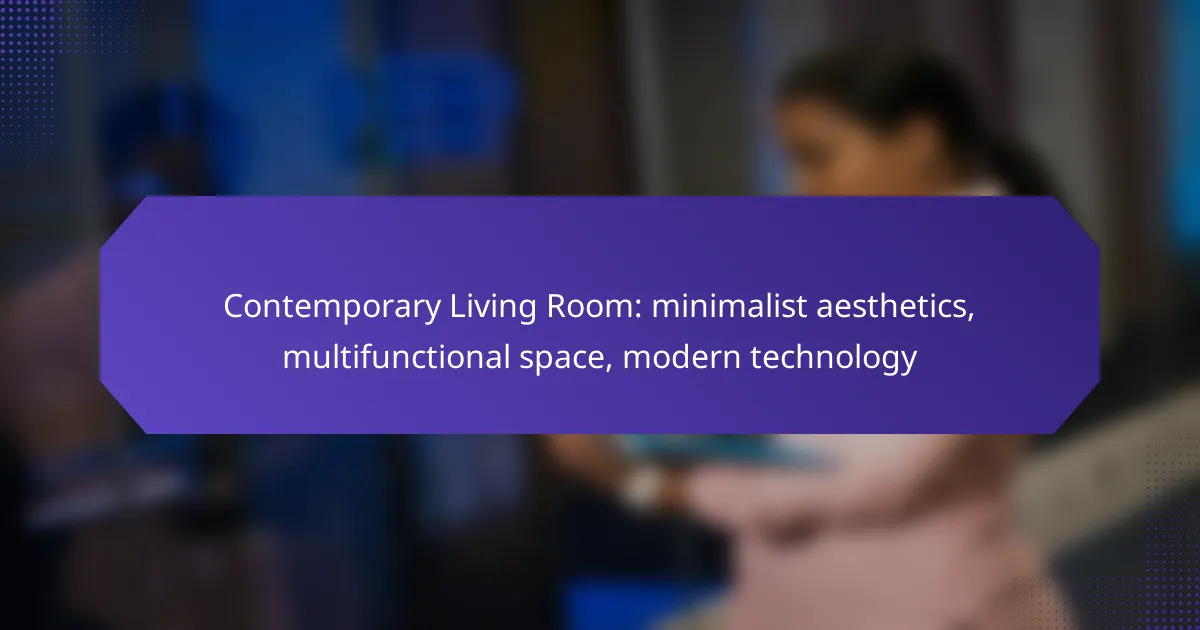A contemporary living room embodies minimalist aesthetics by prioritizing simplicity and functionality, featuring clean lines and a cohesive color palette. The integration of multifunctional furniture maximizes space and utility, while modern technology enhances comfort and usability, creating a versatile environment that meets the demands of today’s lifestyles.

How to create a minimalist living room?
To create a minimalist living room, focus on simplicity and functionality while incorporating modern design elements. This approach emphasizes clean lines, a limited color palette, and multifunctional furniture to enhance both aesthetics and usability.
Use neutral color palettes
Neutral color palettes are essential in minimalist design, as they create a calm and cohesive environment. Shades like whites, beiges, grays, and soft earth tones help to visually expand the space and promote tranquility.
Consider using a combination of these colors on walls, furniture, and decor. For instance, a light gray sofa paired with cream-colored walls can create a serene backdrop for your living area.
Incorporate functional furniture
Functional furniture is crucial in a minimalist living room, as it maximizes space while serving multiple purposes. Look for pieces like coffee tables with storage, sofas that convert into beds, or ottomans that can double as seating.
Choose furniture that is sleek and unobtrusive, avoiding bulky items that can overwhelm the space. For example, a slim console table can provide surface area without taking up too much room.
Maximize natural light
Natural light enhances the minimalist aesthetic by making spaces feel larger and more inviting. Use sheer curtains or blinds that can be easily opened to allow sunlight to flood in.
Position mirrors strategically to reflect light and create the illusion of more space. A well-placed mirror opposite a window can significantly brighten the room.
Declutter and simplify decor
Decluttering is vital in achieving a minimalist living room. Remove unnecessary items and keep only those that serve a purpose or bring joy. Aim for a few well-chosen decorative pieces rather than an abundance of knick-knacks.
Establish a regular cleaning routine to maintain a tidy space. Consider using storage solutions that blend seamlessly with your decor, such as built-in shelves or decorative baskets, to keep items organized and out of sight.

What multifunctional furniture is best for modern living rooms?
Multifunctional furniture enhances modern living rooms by maximizing space and utility. Key options include convertible sofas, storage ottomans, and wall-mounted desks, each offering unique benefits for a minimalist aesthetic.
Convertible sofas
Convertible sofas serve as both seating and sleeping solutions, making them ideal for small living spaces. Models often include mechanisms that allow for easy transformation from a sofa to a bed, providing comfort without sacrificing style.
When selecting a convertible sofa, consider the size and design that fits your room’s aesthetic. Look for options with durable fabrics and sturdy frames to ensure longevity, especially if used frequently as a bed.
Storage ottomans
Storage ottomans combine seating and storage, making them practical additions to contemporary living rooms. They can be used as footrests, extra seating, or even coffee tables, while concealing items like blankets or magazines inside.
Choose storage ottomans that match your decor and are easy to open. Consider the capacity and ensure they are lightweight enough to move around as needed, enhancing flexibility in your space.
Wall-mounted desks
Wall-mounted desks are excellent for creating a functional workspace without occupying floor space. They can be folded away when not in use, maintaining a clean and minimalist look in your living room.
When installing a wall-mounted desk, ensure it is at a comfortable height and sturdy enough to support your equipment. Look for designs that include shelves or compartments for added storage, optimizing your workspace efficiency.

How can technology enhance a contemporary living room?
Technology can significantly enhance a contemporary living room by integrating smart devices that improve functionality, comfort, and aesthetics. These advancements allow for a multifunctional space that caters to modern lifestyles while maintaining a minimalist look.
Smart lighting systems
Smart lighting systems allow you to control the ambiance of your living room with ease. These systems can be programmed to adjust brightness and color temperature based on the time of day or activity, such as reading or watching movies.
Consider options like LED bulbs that can be controlled via smartphone apps or voice commands. Popular brands offer systems that range from basic dimming capabilities to complex setups that sync with music or movies, enhancing the overall experience.
Integrated sound systems
Integrated sound systems provide high-quality audio throughout your living room without the clutter of traditional speakers. These systems can be built into walls or furniture, maintaining a sleek appearance while delivering immersive sound.
Look for wireless options that connect to your smart devices, allowing you to stream music or podcasts effortlessly. Brands often offer systems that can be customized based on room size, with some setups featuring surround sound capabilities for an enhanced viewing experience.
Smart home assistants
Smart home assistants serve as central hubs for controlling various devices in your living room. These voice-activated devices can manage lighting, sound systems, and even temperature settings, making your space more convenient and user-friendly.
When choosing a smart home assistant, consider compatibility with your existing devices and the range of features offered. Popular options include those that can integrate with security systems and provide reminders or updates, enhancing both functionality and security in your living room.

What are the key design principles of minimalist aesthetics?
Minimalist aesthetics prioritize simplicity, functionality, and open spaces to create a serene living environment. This design philosophy emphasizes the use of essential elements while eliminating unnecessary clutter, making it ideal for contemporary living rooms.
Emphasis on simplicity
Simplicity is at the heart of minimalist design, focusing on clean lines and a limited color palette. This approach often involves selecting a few key pieces of furniture and decor that serve a purpose while contributing to the overall aesthetic.
To achieve simplicity, consider using neutral colors like whites, grays, and beiges, which create a calm atmosphere. Avoid ornate details and instead opt for sleek, functional designs that enhance the space without overwhelming it.
Focus on functionality
In minimalist aesthetics, every element should serve a functional purpose. This means choosing furniture that not only looks good but also meets the needs of daily life, such as a coffee table with storage or a sofa that converts into a bed.
When selecting items for your living room, prioritize multifunctional pieces that maximize utility while minimizing space. For example, a modular sofa can adapt to various configurations, making it a practical choice for smaller areas.
Use of open spaces
Open spaces are essential in minimalist design, promoting a sense of freedom and tranquility. This can be achieved by arranging furniture to create clear pathways and avoiding overcrowding the room with too many items.
Consider using furniture that is low-profile to maintain sightlines and enhance the feeling of spaciousness. Additionally, incorporating large windows or mirrors can help reflect light and create an illusion of a larger area, further emphasizing the open space concept.

How to choose the right color scheme for a minimalist living room?
Choosing the right color scheme for a minimalist living room involves selecting a palette that enhances simplicity and functionality. Focus on neutral tones and subtle contrasts to create a serene atmosphere while ensuring the space remains inviting and cohesive.
Consider monochromatic tones
Monochromatic color schemes utilize varying shades of a single color, which can create a harmonious and sophisticated look. For a minimalist living room, consider shades of white, gray, or beige to maintain a clean aesthetic. This approach simplifies the design and allows for easy integration of furniture and decor.
When using monochromatic tones, balance is key. Incorporate different textures and materials to add depth without overwhelming the space. For instance, pairing a soft gray sofa with a lighter gray rug can create visual interest while adhering to minimalist principles.
Incorporate accent colors
Accent colors can add personality and warmth to a minimalist living room without compromising its simplicity. Choose one or two accent colors that complement your monochromatic base, such as a deep blue or a muted green. These colors can be introduced through cushions, artwork, or decorative items.
Be mindful of the quantity of accent colors used; too many can disrupt the minimalist feel. A good rule of thumb is to keep accent colors to about 10-20% of the overall color scheme to maintain balance and focus.
Use color psychology
Color psychology plays a significant role in how a space feels and functions. For a minimalist living room, consider colors that promote calmness and relaxation, such as soft blues and greens. These hues can help create a tranquil environment conducive to unwinding.
Conversely, if you want to energize the space, consider warmer tones like soft yellows or muted oranges. However, use these sparingly to avoid overwhelming the minimalist aesthetic. Aim for a thoughtful selection of colors that align with the mood you wish to cultivate in your living room.










